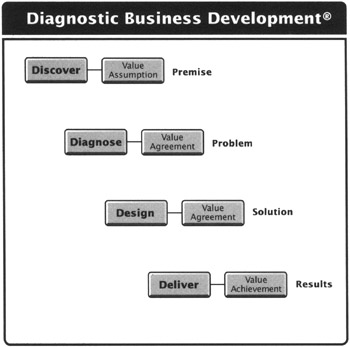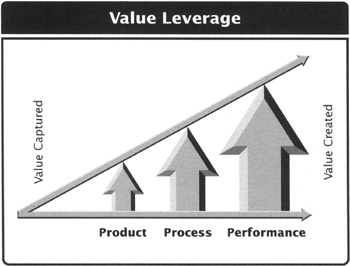
|


|
Creating Value through The Business Development Method
Value is a critical concept that no salesperson can afford to ignore. Value can be defined as incremental results the customer is willing to pay for. To successfully complete a sale, salespeople know that they must be able to create value for their customers and they must be able to capture a reasonable share of that value for their company.
Most salespeople are unable to manage the challenge of creating and capturing value for two reasons:
-
The increasing commoditization of their offerings renders their ability to communicate that value to customers ineffective.
-
The increasing complexity of problems and solutions makes it ever more difficult for customers to comprehend the true value of their solutions when that value is present.
Even when their managers instruct them to create and capture value, they are rarely told how to accomplish this feat. As a result, value creation is more of a buzzword than a tangible reality.
This process offers a two-part answer to that dilemma. First, it is a unique value-based process that is connected to value in a lock-step progression. Thus, as you complete each of the four phases of the process, your customer is one step further along the path to attaining value.
We all approach our work from a value proposition established in our companies. These propositions, which are usually stated in the most general terms, define the markets addressed by our solutions and identify the potential value our solutions offer that group of customers. The guidance provided by value propositions gives us a platform from which we can undertake the Discover phase of the process.
In discovery, we identify a prospective customer and refine our value proposition in the specific terms of that customer's likely business situation, problems, and objectives. We literally tailor the value proposition so it fits a single customer. We call this version of the value proposition a value assumption (see Figure 3.4). The value assumption is a hypothesis as to the value we believe we could bring to this specific customer. The key point is we are not making a boastful claim; we are discussing possibilities.
In turn, a value assumption becomes the premise for the diagnosis. In the Diagnose phase, we further develop and test the assumptions we have made about the definition and scope of the customer's situation. We determine to what degree our assumptions are correct; that is, the symptoms and indicators are occurring in the customer's business. We identify and quantify the impact of the absence of our value. To the degree the assumptions are correct and the customer agrees with us, we have the beginnings of value agreement with the customer on the dimensions of the problem.
We continue the evolution of the value agreement during the Design phase. The objective of the Design phase is to collaborate with the customer to create a solution that is aligned with the issues and expectations of the customer. The outcome of the Design phase is a value agreement with the customer on the dimensions of the value our solution will bring to the customer.
With a complete value agreement defined, we can move to the final step of our process - Deliver. In the Deliver phase, we implement the solution and measure results. Delivering value to the customer is the ultimate and highest goal of salespeople: value achievement for our customers and ourselves. The integrated process is shown in Figure 3.3.
Second, this process enables sales professionals to leverage the value they deliver to customers at three levels. In ascending order of complexity, profitable return, and competitive advantage, these are the Product, Process, and Performance levels of value.
At the Product level, the value focus is on the product or service itself. Product quality, availability, and cost are the major sources of value at this level. Typically, the salesperson is dealing with purchasing and competing with like products and services.
Conventional sales strategies are limited to the leverage of value at the Product level. They make only the most tenuous connection with the customer. Thus, in their customers' eyes, this is a commodity sale, subject to the price pressures we have already described.
At the Process level, the delivery of value is expanded from the product (or service) being sold to the process in which the customer will use it. The optimization of the process becomes the major source of value at this level. Typically, the salesperson and his team are working with operating managers in the various departments at a tactical level. The sale itself becomes an integral part of a process improvement effort.
At the Process level of value, sales professionals are creating a limited partnership with the customer. In their customers' eyes, this sale delivers a greater degree of value than a commodity-based transaction, but the relationship has shallow roots. It can easily lose its value for the customer when the process is optimized or if the process becomes outmoded or is eliminated.
The Performance level offers the greatest potential for value leverage and it is the highest value level which a sales professional can achieve. The development of the customer's business becomes the major source of value at this level. Typically, the sales professional is working with senior executives, as well as the operations level, and the sale is only one manifestation of an ongoing relationship that is connected to the organization at an enterprise level.
As sales professionals are creating and capturing the optimal value at the Product and Process levels; their ultimate objective is to reach the Performance level. At this level, they create strategic partnerships with their customers. In their customers' eyes, the sale is an investment in a more profitable future and the relationship with the seller is a valuable asset. Relationships like this are not easily uprooted. (The relationship among the three levels of value is shown in Figure 3.5.)
In terms of value leverage, it is important to note that we define customers in a broad sense that includes all sales channels. For instance, if you are delivering products and services through a distribution network or channel partners, you should be considering how to enhance each of their businesses, as well as your end-users' businesses, at the Product, Process, and Performance levels.
In this chapter, we introduced the systems, skills, and disciplines behind controlling the enterprise sale. In the next four chapters, we show each phase of the process in greater detail to help you better understand how the major elements of the enterprise sale operate in practice and to help you get the results you are looking for.
The topics covered herein concern solution sales, consultative sales, and consultative selling.

|


|

